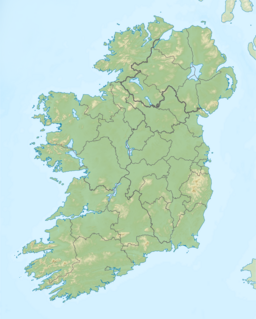Rinn Lough
| Rinn Lough | |
|---|---|
 Walled gardens of Lough Rynn Castle from far side of the lake | |
 Location in Ireland | |
| Location | County Leitrim |
| Coordinates | 53°53′3″N 7°50′52″W / 53.88417°N 7.84778°WCoordinates: 53°53′3″N 7°50′52″W / 53.88417°N 7.84778°W |
| Native name | Claonloch (Irish) |
| Primary inflows | Cloone River |
| Primary outflows | |
| Catchment area | 178.06 km2 (68.7 sq mi) |
| Basin countries | Ireland |
| Max. length | 4 km (2.5 mi) |
| Max. width | 0.7 km (0.4 mi) |
| Surface area | 1.65 km2 (0.64 sq mi) |
| Surface elevation | 39 m (128 ft) |
| Islands | 6 |
| Settlements | Mohill |
| References | [1][2][3] |
Rinn Lough (Irish: Claonloch, also Irish: Loch na Reanna),[1] also known as Lough Rynn, is a freshwater lake in the northwest of Ireland. It is located in south County Leitrim.
Geography[]
Rinn Lough measures about 4 km (2.5 mi) long and 1 km (0.6 mi) wide. It is located about 4 km (2 mi) south of Mohill. Lough Rynn Castle, a medieval castle now a hotel, occupies an estate on the lake's northeastern shore.[2]
Hydrology[]
Two smaller neighbouring lakes drain into Rinn Lough: Clooncoc Lough and Lough Errew. Rinn Lough drains south into the flowing into Lough Forbes. Part of the river forms the Rinn River Natural Heritage Area.[2][4]
Ecology[]
The water quality was reported to be satisfactory c. 2001 – c. 2006 maintaining a mesotrophic rating.[5][6][n 1] but given a "bad ecological status" c. 2007 – c. 2009 due to pollution.[8] Zebra mussel infestation is present.[6] The ecology of Rinn Lough, and Irish waterways, remains threatened by curly waterweed, zebra mussel, and freshwater clam invasive species.[9][10]
See also[]
- List of loughs in Ireland
References and notes[]
Notes[]
- ^ Trophic states of "Oligotrophic" and "Mesotrophic" are desirable, but freshwater lakes rated 'Eutrophic' or 'Hypertrophic' indicates pollution.[7]
Primary sources[]
- ^ Jump up to: a b "Claonloch/Rinn Lough". Placenames Database of Ireland. Government of Ireland - Department of Arts, Heritage and the Gaeltacht. Retrieved 28 December 2015.
- ^ Jump up to: a b c Google (28 December 2015). "Rinn Lough" (Map). Google Maps. Google. Retrieved 28 December 2015.
- ^ "A Reference Based Typology and Ecological Assessment System for Irish Lakes" (PDF). Environmental Protection Agency (Ireland). 2006. p. 19. Retrieved 28 December 2015.
- ^ "Rinn River NHA" (PDF). National Parks and Wildlife Service (Ireland). Retrieved 28 December 2015.
- ^ Clenaghan, Clinton, Crowe 2005, pp. 97.
- ^ Jump up to: a b EPA 2010, pp. 80.
- ^ Clenaghan, Clinton, Crowe 2005, pp. 8.
- ^ EPA 2010, pp. 7, 84.
- ^ Pedreschi, Kelly-Quinn, Caffrey, O’Grady, Mariani, Phillimore 2014.
- ^ Clenaghan, Clinton, Crowe 2005, pp. 16.
Secondary sources[]
- Clenaghan, Conor; Clinton, Frank; Crowe, Matthew (2005). Phosphorus Regulations National Implementation Report (PDF) (Report). Environmental Protection Agency, Office of Environmental Enforcement.
- Pedreschi, D.; Kelly-Quinn, M.; Caffrey, J; O'Grady, M.; Mariani, S.; Phillimore, A. (2014), "Genetic structure of pike (Esox lucius) reveals a complex and previously unrecognized colonization history of Ireland", Journal of Biogeography, Journal of Biogeography, 41(3), 548–560., 41 (3): 548–560, doi:10.1111/jbi.12220, PMC 4238397, PMID 25435649
- EPA (2010). Martin McGarrigle; John Lucey; Micheál Ó Cinnéide (eds.). Water Quality in Ireland 2007-2009 (PDF) (Report). EPA, Aquatic Environment Office of Environmental Assessment.
- Lakes of County Leitrim
